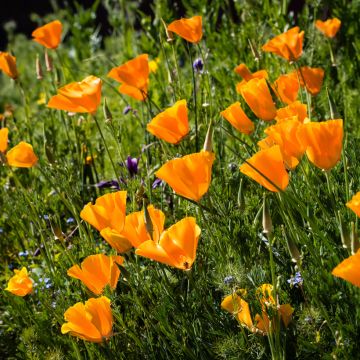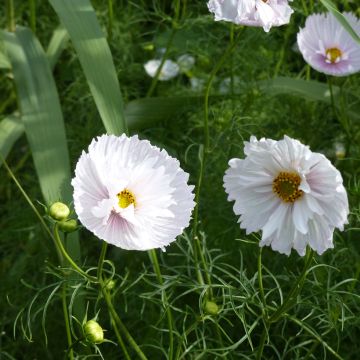

Graines de Viola Floral Powers Mixed F1
Viola Floral Powers Mixed F1 Hybrid - Pansy
Viola x wittrockiana Floral Powers Mixed F1 Hybrid
Garden Pansy, Pansy
Sown on the day of reception (flower day), await germination.
Jean-François A., 02/07/2018
Special offer!
Receive a €20 voucher for any order over €90 (excluding delivery costs, credit notes, and plastic-free options)!
1- Add your favorite plants to your cart.
2- Once you have reached €90, confirm your order (you can even choose the delivery date!).
3- As soon as your order is shipped, you will receive an email containing your voucher code, valid for 3 months (90 days).
Your voucher is unique and can only be used once, for any order with a minimum value of €20, excluding delivery costs.
Can be combined with other current offers, non-divisible and non-refundable.
Home or relay delivery (depending on size and destination)
Schedule delivery date,
and select date in basket
This plant carries a 6 months recovery warranty
More information
We guarantee the quality of our plants for a full growing cycle, and will replace at our expense any plant that fails to recover under normal climatic and planting conditions.

Would this plant suit my garden?
Set up your Plantfit profile →
Description
This delightful mix of very dense and floriferous plants proves to be one of the best introductions in terms of pansies in recent years. Among the most floriferous, the Viola 'Floral Powers Mixed' F1 displays large flowers and, as its name suggests, perfectly embodies the famous 'flower power'. This biennial blooms from late winter until summer, in a beautiful range of bright, solid or bicoloured flowers, flooding borders, flower beds, and hanging baskets.
The group of Viola x williamsii includes hybrids belonging to the violet family, resulting from the cross-breeding of V. wittrockiana (garden pansy) and V. cornuta, the horned violet. The 'Floral Powers Mixed' F1 selection consists of plants with a low, branched habit, forming bushy clumps 20cm (8in) tall and 15cm (6in) wide. They are distinguished by their rapid growth and extraordinary floribundity. Depending on the sowing date, these pansies will be in bloom from late winter to the heart of summer. The flowers are quite large and continuously renew on the medium green foliage. They are adorned with bright colours, on their solid or bicoloured corollas formed by 5 petals. They are white, yellow, orange, blue, violet or mauve, sometimes yellow and brown or white and mauve, and are illuminated by a beautiful golden-yellow spot at the base of the 3 lower petals. The flowers resemble those of pansies, but their petals are arranged differently. The top two are erect, while the other three are inclined downwards. The plant spreads quite rapidly thanks to its rhizomes and also self-seeds very easily in the garden, not always faithfully.
Pansies, like horned violets, are intended for low mass flowering, borders, as well as pots and balconies, where they will be associated with other spring and summer flowering plants (Forget-me-nots, Dwarf Daffodils, Daisies, Primroses, Botanical Tulips, Summer and Autumn Asters...). The flowers of pansies and horned violets are edible, so feel free to decorate your plates with one or two flowers, or even add some to your salads to give them a touch of colour.
Flowering
Foliage
Plant habit
Botanical data
Viola
x wittrockiana
Floral Powers Mixed F1 Hybrid
Violaceae
Garden Pansy, Pansy
Cultivar or hybrid
Other Thompson and Morgan seeds
View all →Planting and care
Sow spring pansies from autumn on the surface of a good specific research area compost. Spring sowings will produce flowers in early summer, while summer and autumn sowings will bloom in winter or spring.
Place the seed tray in a mini-greenhouse at a temperature of 15-20 °C (59-68°F), or enclose it in a polyethylene bag. Keep the soil moist but not waterlogged. Be careful not to provide too high a temperature, as this can inhibit germination. Do not exclude light as this promotes germination, which usually takes 14 to 21 days.
When the seedlings are large enough to handle, transplant and grow them in cooler conditions until they are big enough to be planted outside. When the pansies are well developed and all risk of frost has passed, acclimatize them to outdoor conditions for 7 to 10 days. Plant them in well-drained soil, in pots, hanging baskets or containers, outside, in full sun or partial shade. Autumn sowings will overwinter under cold frames and then be planted outside the following spring.
Sowing period
Intended location
Planting & care advice
-
, onOrder confirmed
Reply from on Promesse de fleurs
Haven't found what you were looking for?
Hardiness is the lowest winter temperature a plant can endure without suffering serious damage or even dying. However, hardiness is affected by location (a sheltered area, such as a patio), protection (winter cover) and soil type (hardiness is improved by well-drained soil).

Photo Sharing Terms & Conditions
In order to encourage gardeners to interact and share their experiences, Promesse de fleurs offers various media enabling content to be uploaded onto its Site - in particular via the ‘Photo sharing’ module.
The User agrees to refrain from:
- Posting any content that is illegal, prejudicial, insulting, racist, inciteful to hatred, revisionist, contrary to public decency, that infringes on privacy or on the privacy rights of third parties, in particular the publicity rights of persons and goods, intellectual property rights, or the right to privacy.
- Submitting content on behalf of a third party;
- Impersonate the identity of a third party and/or publish any personal information about a third party;
In general, the User undertakes to refrain from any unethical behaviour.
All Content (in particular text, comments, files, images, photos, videos, creative works, etc.), which may be subject to property or intellectual property rights, image or other private rights, shall remain the property of the User, subject to the limited rights granted by the terms of the licence granted by Promesse de fleurs as stated below. Users are at liberty to publish or not to publish such Content on the Site, notably via the ‘Photo Sharing’ facility, and accept that this Content shall be made public and freely accessible, notably on the Internet.
Users further acknowledge, undertake to have ,and guarantee that they hold all necessary rights and permissions to publish such material on the Site, in particular with regard to the legislation in force pertaining to any privacy, property, intellectual property, image, or contractual rights, or rights of any other nature. By publishing such Content on the Site, Users acknowledge accepting full liability as publishers of the Content within the meaning of the law, and grant Promesse de fleurs, free of charge, an inclusive, worldwide licence for the said Content for the entire duration of its publication, including all reproduction, representation, up/downloading, displaying, performing, transmission, and storage rights.
Users also grant permission for their name to be linked to the Content and accept that this link may not always be made available.
By engaging in posting material, Users consent to their Content becoming automatically accessible on the Internet, in particular on other sites and/or blogs and/or web pages of the Promesse de fleurs site, including in particular social pages and the Promesse de fleurs catalogue.
Users may secure the removal of entrusted content free of charge by issuing a simple request via our contact form.
The flowering period indicated on our website applies to countries and regions located in USDA zone 8 (France, the United Kingdom, Ireland, the Netherlands, etc.)
It will vary according to where you live:
- In zones 9 to 10 (Italy, Spain, Greece, etc.), flowering will occur about 2 to 4 weeks earlier.
- In zones 6 to 7 (Germany, Poland, Slovenia, and lower mountainous regions), flowering will be delayed by 2 to 3 weeks.
- In zone 5 (Central Europe, Scandinavia), blooming will be delayed by 3 to 5 weeks.
In temperate climates, pruning of spring-flowering shrubs (forsythia, spireas, etc.) should be done just after flowering.
Pruning of summer-flowering shrubs (Indian Lilac, Perovskia, etc.) can be done in winter or spring.
In cold regions as well as with frost-sensitive plants, avoid pruning too early when severe frosts may still occur.
The planting period indicated on our website applies to countries and regions located in USDA zone 8 (France, United Kingdom, Ireland, Netherlands).
It will vary according to where you live:
- In Mediterranean zones (Marseille, Madrid, Milan, etc.), autumn and winter are the best planting periods.
- In continental zones (Strasbourg, Munich, Vienna, etc.), delay planting by 2 to 3 weeks in spring and bring it forward by 2 to 4 weeks in autumn.
- In mountainous regions (the Alps, Pyrenees, Carpathians, etc.), it is best to plant in late spring (May-June) or late summer (August-September).
The harvesting period indicated on our website applies to countries and regions in USDA zone 8 (France, England, Ireland, the Netherlands).
In colder areas (Scandinavia, Poland, Austria...) fruit and vegetable harvests are likely to be delayed by 3-4 weeks.
In warmer areas (Italy, Spain, Greece, etc.), harvesting will probably take place earlier, depending on weather conditions.
The sowing periods indicated on our website apply to countries and regions within USDA Zone 8 (France, UK, Ireland, Netherlands).
In colder areas (Scandinavia, Poland, Austria...), delay any outdoor sowing by 3-4 weeks, or sow under glass.
In warmer climes (Italy, Spain, Greece, etc.), bring outdoor sowing forward by a few weeks.




















































